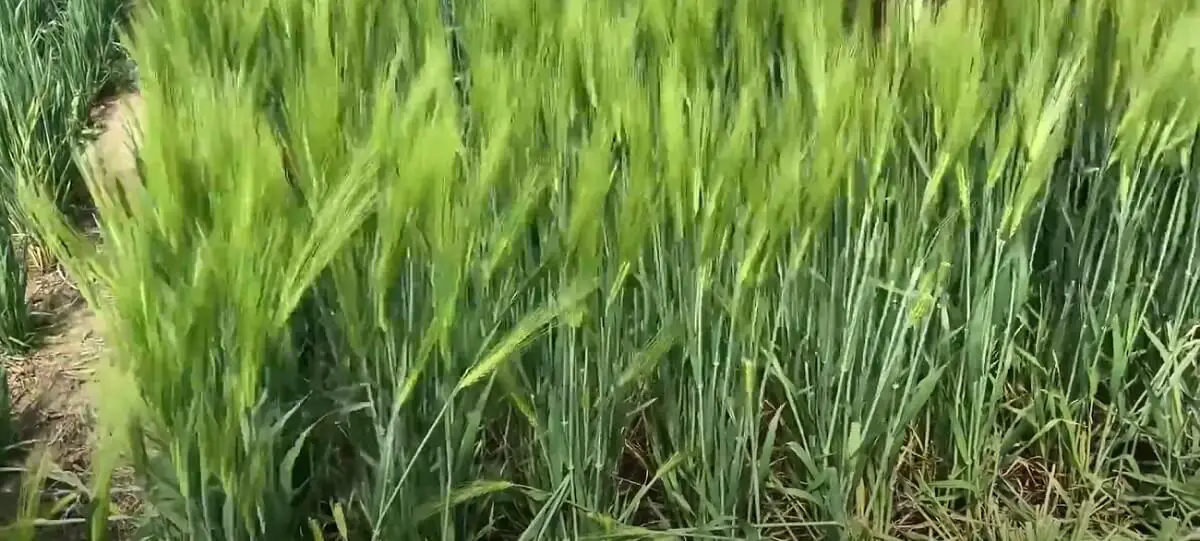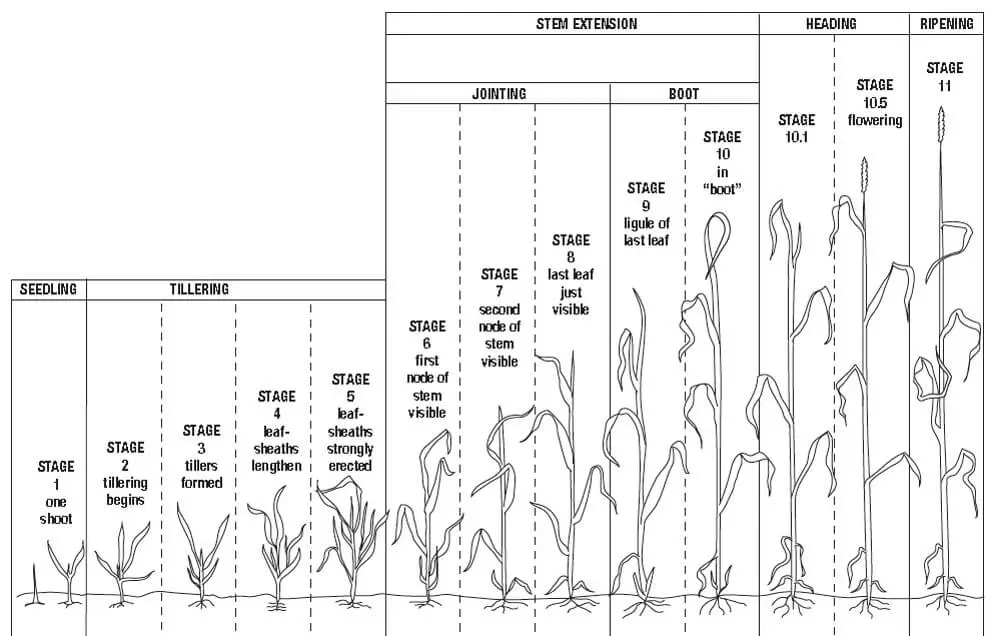Growing Winter Barley Guide What You Need To Know
Winter Barley A Green Manure Cover Crop

Many gardeners are looking for a cover crop that will not reseed on our gardens and can get tilled into the soil to improve its quality. Winter barley is a great choice and is one of the first domesticated crops.[2]
When Spring comes, we can use it as a source of green manure to add some additional nutrients to the soil, reducing our use of synthetic fertilizers.
Because it's so simple to grow and requires minimal tending, it has gained popularity with many gardeners.
It is one of the shortest seasons of any cereal crop.
Many people beleive that the barley crop dies over the winter since it is common to see everything above the ground burn off during the winter. But in early Spring, it will green up and start growing again.
Barley is less aggressive than rye in competing for resources, making it useful as a weed management option without competing against your other plants.
Winter Barley Growth Stages
- 1) Germination
- 2) Seedling growth
- 3) Tillering
- 4) Stem Extension

Planting Winter Barley
You will want to get the winter barley in about 10 to 15 days before you would plant winter wheat.
We want to get our seeds planted about 45 days before we expect our first frost to give the barley roots enough time to grow deep enough to survive over the winter months.
Before we plant our barley, we will have to prepare the soil first. Use a spade to help break up the ground and provide better aeration. Use a garden rake to break up the dirt and level your garden plot.
For the best growth possible, we want our soil pH to be between 6 and 7, but the barley will still perform well in a range between 5 and 8.
You will aim to plant the barley seeds between 1 and 1.5 inches deep. We want the barley deep enough to have access to moisture while still allowing them to sprout as quickly as possible.
If you are growing the barley as an actual crop, the seeds should get planted about 5 inches apart. As a cover crop, use a garden rake to remove an inch of soil and lay down your seeds, covering as much of your garden bed as possible.
Cover the seeds and water well, ensuring your garden plot is entirely soaked.
Winter Barley Germination Time
On average, it will take 6 to 8 days for winter barley to germinate, but it can take up to 2 weeks.
The minimum temperature for barley germination is 34 to 36 degrees Fahrenheit (1 to 2 degrees Celsius).
After the primary root (radicle) emerges, it grows downward and eventually develops lateral branching.
The first main shoot leaf remains enclosed in the coleoptile to protect it as it penetrates the soil.
How Tall Does Winter Barley Grow
This is going to depend on how long you allow it to grow. I like to cut it down on my plot when it reaches around one foot.
But if you leave it and the time and weather permitting, you can see it reach a height of 2 to 4 feet tall.[6]
What to do With Winter Barley in the Spring
The springtime is when our winter barley is most susceptible to dying off. Most of us think the winter killed it off, but spring wake-up and freeze-thaw patterns cause the problem.
One way to help it survive through early Spring when the night might still get cold enough to freeze the barley is by using a cover as a barrier between our barley and the wind and night chill.
Using a traditional garden blanket, commercial plant tarp, or even placing a bed sheet over them can be enough to help them survive through some extra colder nights.[5]
Is Winter Barley a Good Cover Crop
Winter barley is a cool-season annual cereal grain. When added to our gardens, it provides erosion control, suppresses weeds, and adds extra organic matter into our soil while acting as a topsoil protectant crop during drought.
Winter barley will produce a high amount of biomass in a short time frame compared to other cereal crops. The short growth period allows it to get planted farther north than any other grain type.
The extra organic material makes it a good choice when looking for a source of green manure to further improve our health, aeration, and soil fertility.
When the barley is growing, the fibrous roots can go as deep as 6 feet helping to improve our soil's structure. Large rooting networks significantly increase the organic matter while suppressing weeds, scavenging nutrients, and attracting beneficial microorganisms.
The roots are also excellent at supporting mycorrhizal fungi to increase.
Its low price point, easy growth, and wide range of conditions it can grow under make it an attractive choice for home gardeners and farmers.
Winter barley cover crops prefer cool, dry growing regions and are hardy to USDA growing zone 8 or warmer.[1]
What Is Winter Barley Used For
Being quick to mature allows farmers to double-crop soybeans in longer-season areas.
It gets used as a cover crop to help protect the soil from erosion over the winter months.
Provides high levels of feed for farmers livestock and straw.
When it is grown to spec, it gets used to create malt.
How Late Can You Plant Winter Barley
If you need a cover crop that you can plant as late as possible, you must focus on winter wheat, not barley. Barley needs additional time for its root development to survive winter and the Spring thaw freeze pattern.
You will want to plant your winter barley about 45 days before you expect your first frost. Planting any later than this will reduce our winter barley's chance of surviving.
How Do You Kill Winter Barley?
The two most common methods to kill barley cover crops are mowing or using a burn-down herbicide for no-till plantings.
No-till barley is an effective method to prevent erosion and weeds from moving in.
After mowing, you will want to till the barley into your soil.
Tilling Winter Barley
Where I live, the cold comes quickly, and I want rooted plants helping to prevent soil erosion. So I let it grow a little for a couple of weeks during Spring and then till it into my garden.
Remember, when winter comes, the barley will go dormant until Spring arrives. When the barley growth resumes, you can wait until it hits that half-foot mark and till it into your garden plot.
Tilling your winter barley crop into the soil is a great way to help improve the ground's tilth, fertility, and aeration.
The nutrients in your cover crop will also slowly release, acting as a natural fertilizer.
Green manure is one of my favorite ways to provide additional nutrients for my future plants. It's important to wait at least one week before planting your next crop to allow the barley to begin to decay into the soil.
Winter Barley Varieties
- 1) Valerie Winter Barley
- 2) KWS Cassia Winter Barley
- 3) KWS Gimlet Winter Barley
- 4) KWS Cassia Winter Barley
- 5) SY Kingsbarn Winter Barley
- 6) Bazooka Winter Barley
- 7) Saturn Winter Barley
- 8) P919 Winter Barley
Winter Barley Diseases
Brown Rust: Brown rust most commonly happens in the late season. The warm temperature (15º to 22º C) during high humidity helps the disease develops. Once brown rust starts to grow, dry, windy days will spread it to other nearby plants.
The first symptoms we see are scattered orange-brown bumps on leaves and sometimes on the stems, leaf sheaths, or ears. Look for a yellow halo surrounding the spots. Small black bumps also develop on the underside of the leaf, where the infective spores develop.
Net Blotch: The disease spreads through airborne spores and rain splashes. Net blotch thrives under cool, wet, and humid weather, and it also thrives under thick sowing and early drilling.
At first, you will notice tiny dark brown lesions on the leaves, and they will further develop into short brown strips. Looking closely, you will see a network of brown lines.
Powdery Mildew: Spores spread by wind can bring this disease to your garden. Under warm temperatures (12º to 20ºC) and humid weather promotes its growth in our winter barley. Rapidly growing thick crops with high nitrogen levels are the most vulnerable to the disease.
White fluffy bumps appear on the leaves, the stem, and the ear. The spots can easily get rubbed off and underneath, and the tissue is discolored brown. Over time, the bump will turn brown to black.
Ramularia: The primary source of Ramularia is from the actual seeds having an infection. The secondary infection then happens from the infected plant spreading airborne spores and infecting others around it.
We will first see small irregular brown spots and legions on the lower leaves. When the plant enters flowering, the spots will begin showing up on the top leaves, and the spots go through the leaves and are visible on the plant's top and bottom.
Rhynchosporium: Rain splashes and dew are what spread the disease with cool(10º to 15 º) and wet weather conditions encouraging the growth of the disease.
Large pale green watery oval legions develop on the leaf blades. Over time, the pale green will turn into a pale brown with darker margins. Pay attention to the lower leaves when looking to see if this disease is present.
Yellow Rust: The disease thrives in cool (10º to 15ºC) and humid conditions. Late application of nitrogen also seems to help the disease. Within a week, we can see server infections develop. When the temperature gets above 20ºC, the disease spread stops.
Rust fungi can only grow on green plant tissue. First, they appear as yellow bumps at the apex of the leaves that turn into brown lines creating a stripping effect.
Summary
Winter barley is easy to grow and grows quicker than most cereal crops. You can use it as a cover crop, growing it at the end of the season and then till it into your soil in the Spring, providing green manure into our soils.
Adding green manure to the soil is a perfect way to keep your soil healthy, feed its microorganisms and reduce your need for synthetic fertilizers later in the growing season.
It also breaks up and provides better aeration to the soil because of its deep roots. At the same time, it prevents soil erosion over the winter.
Similar Articles
Growing Winter Peas
Growing Winter Rye
Growing Winter Wheat
[1]https://www.gardeningknowhow.com/edible/grains/cover-crops/growing-barley-cover-crop.htm
[2]https://extension.umn.edu/small-grains-crop-and-variety-selection/winter-barley-emerging-crop
[3]https://ontariograinfarmer.ca/2021/03/01/winter-barley/
[4]https://www.country-guide.ca/crops/barley-getting-through-the-winter/
[5]https://www.gardeningknowhow.com/edible/grains/cover-crops/disadvantages-of-cover-crops
[6]https://plants.usda.gov/DocumentLibrary/plantguide/pdf/pg_hovu.pdf
[7]https://www.agricentre.basf.co.uk/en/News-Events/BASF-Ag-Solutions-News/Winter-barley-disease-control.html
[8]https://www.canr.msu.edu/uploads/234/92815/Shramski_Nate_GLHB_presentation.pdf
[9]https://green-shack.com/how-to-plant-barley/